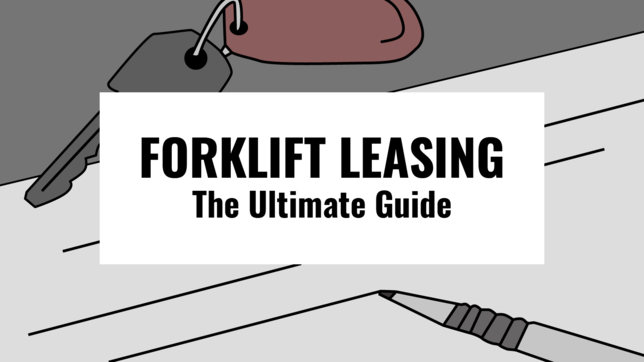This article is all about forklift leasing.
Being in the forklift business for over 65 years, we’ve gotten pretty good at financing and everything that goes along with it.
So we’re going to cover things like:
- The different types of forklift leases, including advantages and disadvantages
- Forklift lease prices
- Whether you should lease or buy a forklift
- Where to find forklift leasing companies
Let’s dive in!
An Overview of Forklift Leasing
Let’s cover some of the features that all forklift leases have in common.
Common Forklift Lease Terms You Should Know
-
Lessor
The person or group that owns the asset being leased and receives payment for its use.
-
Lessee
The person or group who pays for the use of the leased asset.
-
Maturity
The date your lease agreement ends and you either turn in your lift truck, re-lease it, or purchase it.
-
Residual
The value of the lift truck at the end of the lease. The residual is calculated by the leaseholder and is based on the truck’s specifications and the annual hours of usage. As a rough guideline, residuals generally range from 20% to 50% of the purchase price.
-
Fair market value
The value of the leased forklift on the open market. A lift truck’s market value can change based on the economy, brand, equipment specifications, maintenance history, and condition.
-
Depreciation
The amount your lift truck declines in value over the life of your lease.
Forklift Lease Lengths
Forklift leases can range from 12 to 72 months.
But the most common duration is 36 to 60 months.
Forklift lessees generally chose the duration of the lease based on the application.
For example, if it’s a high-usage application, they’ll often choose a shorter term lease.
But if it’s a low-use application, they may extend the lease longer.
How are Forklift Lease Payments Calculated?
Forklift lease rates are determined by:
- The purchase price of the lift truck
- The interest rate (generally ranges from 0% to 5%)
- The length of the lease
- Your operating environment
- The number of hours you’ll use the lift
In general, the longer the lease term is, the lower your monthly payments will be.
What Does it Cost to Lease a Forklift?
A good rule of thumb is that a forklift lease costs $20 per month for every $1,000 financed.
So for a $20,000 forklift, that comes out to $400 per month, for example.
Your Forklift Lease Options Explained
There are several different kinds of forklift leases.
Let’s go through them.
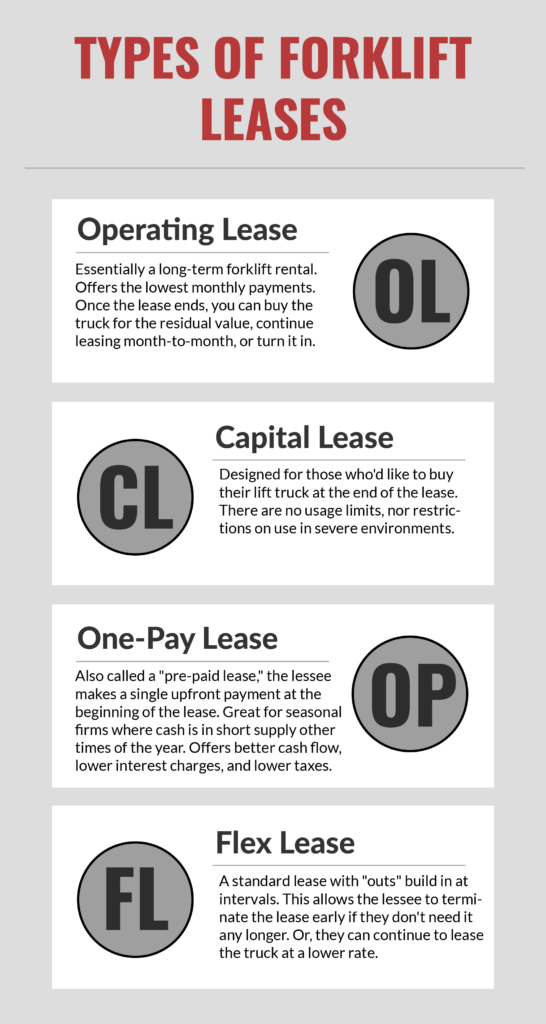
Operating Lease
What Is It?
Also known as fair market value lease (FMV), tax lease, or true lease, an operating lease is the most common type of forklift lease.
Basically, this type of lease allows you to pay for only the time you use the truck instead of the total cost of ownership.
So it’s essentially a long-term forklift rental program.
Like all leases, you are responsible for maintaining the lift truck during the duration of your operating lease.
Forklift Lease with Maintenance: Explained
All types of leases make the lessee responsible for maintaining their lift trucks.
As a lessee, you have a few options for maintaining your trucks.
For one, your internal maintenance team can take care of it, if you have one.
For another, you can contract with a forklift dealership or service company to provide maintenance.
Often, forklift lessees will sign up for a full maintenance plan with the dealership that leased them the lift truck when they sign their lease.
In essence, this is like paying for an extended warranty.
It covers everything from engine and transmission repairs to oil changes.
And while you do pay extra for it each month, there’s no invoice after each service – unlike a planned maintenance contract.
So you won’t have to fork over extra cash after an unexpected repair or servicing.
As far as pricing goes, full maintenance plans are calculated based on equipment hours, operating environment, capacity, and attachments.
That said, it’s typically less than the lease payment.
Ask your dealership to provide you the costs of a full maintenance program with several lease terms to determine how high your maintenance costs will rise.
Overall, full maintenance plans are peace of mind programs.
With them, you’ll rest easy knowing your equipment repairs are covered, so you can avoid downtime and maximize productivity.
And, you’ll be limited to generally 2,000 operating hours per year (though you can adjust the limits in exchange for a higher monthly payment).
Operating leases also leave you with a higher residual value upon maturity of the lease.
So, if you’d like to purchase your lift truck after the lease terminates, an operating lease may not be the best option.
Additionally, you should be aware that if you’re tax liable, your monthly payment will be taxed – but not the residual.
Once the lease is up, you have multiple options:
- Buy the lift truck for the residual value
- Continue leasing it on a month-to-month basis
- Turn it in
Who’s It For?
Overall, an operating lease’s biggest benefit is that it offers the lowest monthly payments of other lease types.
Plus, it provides enough flexibility to allow you to customize for different operational demands, including hours of usage.
Determine when your lease hours are measured. It’s better to have them taken at the end of the lease rather than yearly. That way, you can compensate for periods when usage was lower.
That said, operating leases are not a great option for harsh environments.
Since you’ll eventually need to turn the lift truck in, you’ll be liable for any damage or excessive wear and tear done to the lift truck.
And while you can customize an operating lease to accommodate more hours, you’ll still be liable for overtime charges if you exceed those hours.
So if you anticipate a lot of fluctuations in usage throughout your lease, an operating lease may not be the best choice.
What are the overtime rates for leases?
Overtime is calculated based on lift truck capacity, generally speaking.
Overall, rates can range from less than $1 to over $5 per hour.
Thus, racking up just a few hundred extra hours during your lease can be quite costly.
A better option for high-hour usage is the capital lease, which we’ll cover below.
Capital Lease
What Is It?
A capital lease – also called a full payout lease, $1.00 purchase option lease, and a forklift lease-to-own – is designed for companies that intend to buy the lift truck at the end of the lease.
Unlike an operating lease, a capital lease passes ownership to you once you’ve made all your payments.

In that sense, this type of lease is similar to a loan: you make payments and own it at the end.
And since you’ll end up owning the lift truck, sales tax on the truck’s full purchase price is due upfront.
You can either pay the tax in full upfront or finance it.
Who’s It For?
The unique feature of a capital lease is the low purchase price at maturity.
Typically, the lessee can buy the lift truck for a nominal amount, usually $1.
This type of lease works well for severe operating conditions and high-hour applications.
After all, you’ll own the truck at the end of the lease and not be subject to charges for damage or excessive wear.
Plus, there are no overtime charges for exceeding yearly hour limits.
Can you add a $1 buyout option to other types of leases?
Yes, you can!
Usually, this is done upfront, in which case the lease defaults to a capital lease.
But if you’ve already signed another type of lease, you can still add a buyout option.
In that case, there’s a fee assessed and the terms and payments will change.
One-Pay Lease
What Is It?
Also called a single pay lease or pre-paid lease, a one-pay lease requires you to make a single upfront payment at signing.
Essentially, you’re plunking down a one-lump sum that pays for the amount of time you’re using the lift.
Some of the benefits of a one-pay lease are:
- Lower interest
- No monthly bills
- Lower taxes
- Better cash flow
- Better credit reporting (the forklift leasing company will report your payments every month, even though you paid it all upfront)
But like an operating lease, you are limited to how many hours you can put on the lift truck throughout your lease term.
At the end of the lease, you can:
- Payout the residual and buy the lift truck
- Turn it in
Who’s It For?
Overall, a one-pay lease is a good choice if you have historically paid cash for your material handling equipment and prefer to continue doing so.
And it’s a great option if you have a lot of cash and poor or little credit history.
Since you’re paying the cost upfront, forklift leasing companies will be more likely to approve you, even if you wouldn’t be approved for a standard lease.
Furthermore, one-pay leases are excellent for seasonal work.
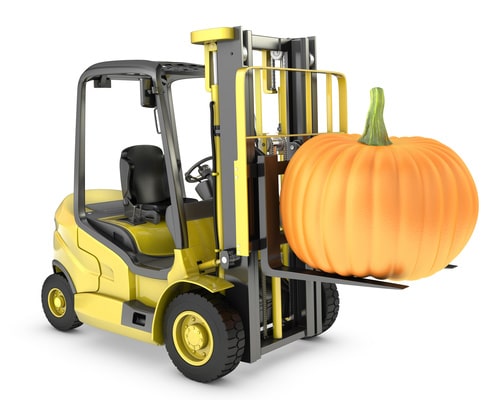
That’s because they allow you to make your payment when you have cash surpluses instead of doing so in leaner times of the year.
The downside of a one-pay lease though is that you need to be willing to assume some risk.
Since you’re paying for the lift truck upfront, you risk something happening to it.
And if something does happen, insurance will only cover the market value of the truck – not what you actually paid for it.
What is a Retail Installment Loan?
A retail installment loan is similar to a capital lease.
You simply make monthly payments, and in the end, you own it.
But instead of it being a lease, it’s financed.
Flex Lease
What Is It?
A flex lease is a lease with “outs” built-in where you can turn in your lift truck early or continue to lease it with lower monthly payments.
With a flex lease, the first term’s payments are higher.
Then for the second term, the payments are lower.
But be aware: You must opt-in for the second term or you’ll pay the higher payments from the first term.
At the end of your lease, or the start of an “out,” you can:
- Extend the lease at a lower monthly rate
- Return the forklift
Who’s It For?
Ultimately, a flex lease gives you more flexibility to cope with market fluctuations and inconsistent usage over other types of leases.
It’s a great option, for instance, if you have a lot of business with a particular contract but aren’t sure if the contract will continue in the future.
Signing a flex lease will allow you to align your lease terms with your contract terms and turn in your equipment early if the contract doesn’t extend.
That way, you can and avoid being stuck with a truck that you no longer have use for.
Comparing the Different Types of Forklift Leases
| Feature | Operating Lease | Capital Lease | One-Pay Lease | Flex Lease |
|---|---|---|---|---|
| Responsible for maintenance? | Yes | Yes | Yes | Yes |
| Restricted operating hours? | Yes | No | Yes | Yes |
| Good for severe operating environments? | No | Yes | No | No |
| Residual? | $$$ | $ | $$$ | $$$ |
| Upfront payment? | No | No | Yes | No |
| Monthly payments? | $ | $$ | None | $$ |
| Turn in equipment early? | No | Yes | No | No |
Forklift Leasing vs. Buying: 5 Factors to Help You Decide Which Is Best For You
Now that you know the ins and out of the different types of leases, you may be wondering still whether you should lease or buy your next forklift.
Here are 5 key considerations to help you make your final decision.
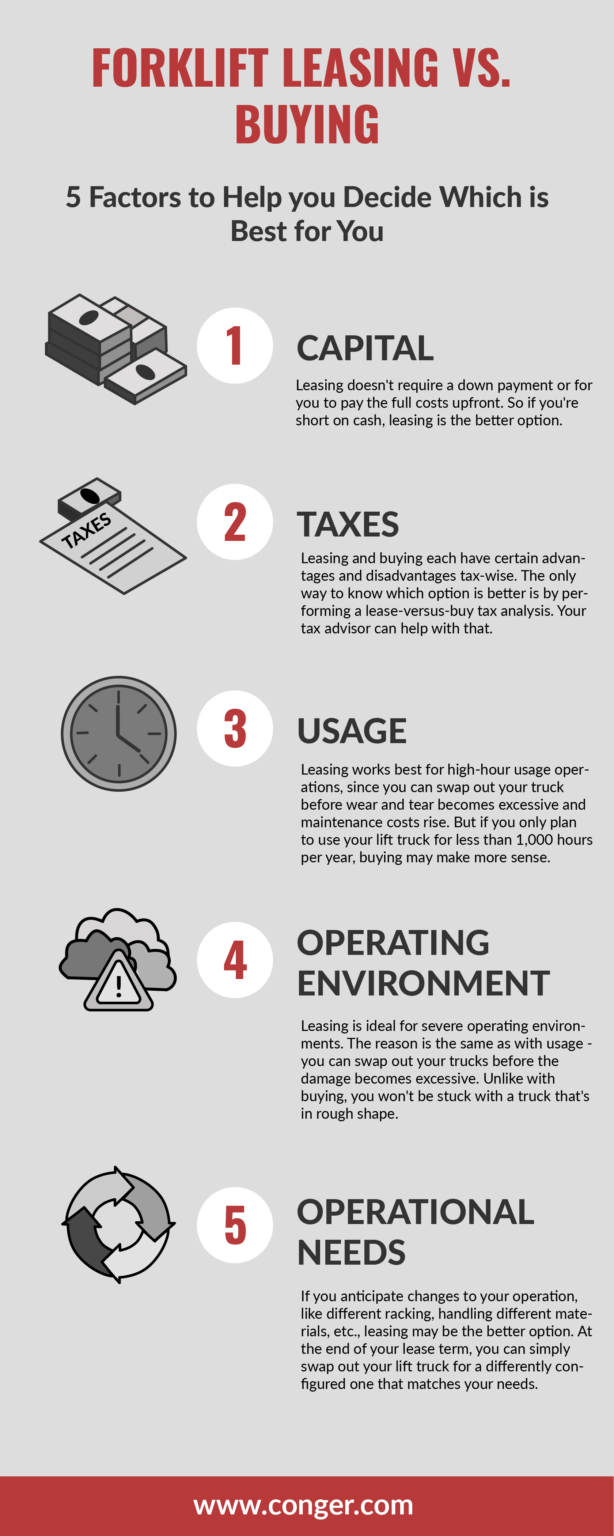
Capital
If you have a tight budget, you’ll obviously have to prioritize where your funds go.
Since purchasing involves putting down a down payment or paying the full amount upfront, you may not have the funds to be able to do that.
That’s where leasing can be a better alternative since you only have the monthly payments to worry about.

Moreover, forklift leasing only requires that you pay for the use of the lift truck, not the total cost of ownership.
This can be especially attractive if you have a large fleet of forklifts.
Instead of eating away at your capital, leasing will allow you to invest in other areas of your business while getting the equipment you need to stay operational.
Bottom Line: If you’re low on cash, consider leasing.
Taxes
Leasing and buying each come with specific tax requirements and benefits.
When leasing, you do not own the equipment – you’re only paying for the use of it.
So, your monthly lease payments are treated as expenses, not liabilities.
And you can typically write them off on your taxes.
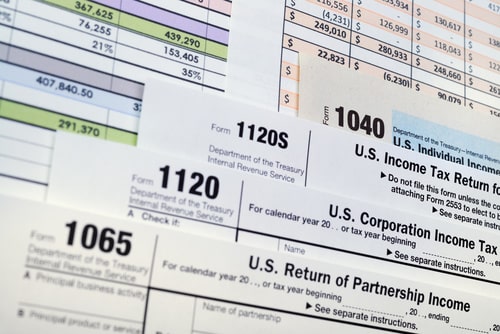
But when buying, the lift truck is considered an asset on your company’s balance sheet, and payments are treated as debt (liability).
So you may be able to claim depreciation and interest deductions.
Of course, there can be many exceptions to these rules, as is usually the case with taxes.
Moreover, whichever arrangement ends up yielding the best tax advantage depends on many other factors too, including:
- Current corporate tax rates and possible changes
- Interest expense deduction limits
- Restrictions and depreciation
- Capitalization abilities
So unfortunately, there’s no across-the-board answer to whether it’s better to lease or buy from a tax perspective.
And that’s why companies should perform a lease-versus-buy tax analysis for each piece of equipment they plan to acquire.
If you’re unsure how to perform such an analysis, you should consult a tax adviser.
Bottom Line: Work with your tax adviser to perform a lease-versus-buy tax analysis to determine which option is best for you.
Usage
Forklift leasing tends to work out best for high-use operations, like manufacturing and warehousing.
The reason is that the more hours are put on a lift truck, the faster it will wear down and maintenance costs will rise.
But when you lease, you can swap out the equipment before those costs become excessive – provided you structure the duration of your lease properly.

As a rule of thumb, the more hours of usage per year, the shorter you want your lease term.
If you intend to use it consistently for more than 3,000 hours per year, get a 36-month lease.
And if you intend to use it consistently more than 1,500 hours per year, go with a 48 to 60-month lease.
When it comes to buying, you’ll want to buy a forklift only if you can use it for 7 to 10 years.
Otherwise, you’ll be eating into your return on investment (ROI).
And considering that 10,000 hours is generally how long a lift truck will last, adding multiple thousands of hours per year won’t get you to that 7 to 10-year mark.
So, if your operation experiences a low (less than 1,000 per year), predictable workflow with few fluctuations, buying may be a better option than leasing.
Bottom Line: If you require high hour usage, consider leasing.
Operating Environment
Will your operating environment be severe, where the lift will be prone to damage, caustic substances, rust, extreme temperature changes, and the like?
In these cases, you’re likely better off leasing your lift truck.
The reason is the same as with usage: you can turn the lift truck in before the damage gets too severe.
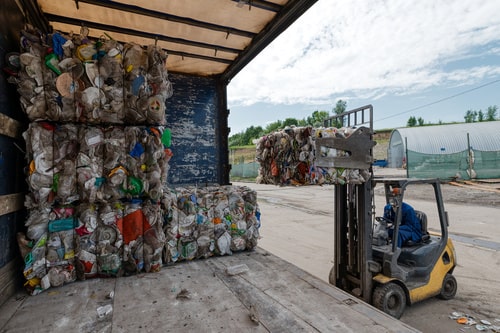
Otherwise, if purchasing, you’ll be stuck with a lift truck in poor shape that likely won’t yield a great return on investment.
But if you only plan to use the fork truck as a spare, where its exposure to inclement conditions will be minimal, purchasing may be a good option.
Bottom Line: If you have severe operating conditions, consider leasing.
Operational Needs
You also need to consider whether or not you expect your operational needs to change.
Some questions you should answer include:
- Do you expect increased demand?
- Will you need a differently-configured forklift?
- Will you be installing a new racking system?
- Working with a different type of material?
- Working in a different type of environment (i.e. cold storage, inside, outdoors)?
- Are you in a constantly-changing industry (like eCommerce) where your needs today may look very different than a few years from now?
If you anticipate any of the above, then leasing may be the better option.

That’s because leasing your forklift – or forklifts – offers you the flexibility of having a revolving door of new, state-of-the-art forklifts.
That way, if your operations change, you can get differently-configured lift trucks to meet your new infrastructure and operational needs.
And since new equipment helps improve efficiency and productivity, you’ll also gain a competitive advantage over competitors who are using outdated equipment.
Bottom Line: If you expect your operations to change, consider leasing.
Pros and Cons of Leasing and Buying a Forklift
Leasing Pros
- Greater Flexibility: Available for new and used forklifts. Lease structures are customizable, including duration and allotted service hours.
- Latest Models and Features: Customize your truck according to what you need operationally. Swap out your lift truck as new models and features appear, or as operational conditions require.
- No Ownership Responsibilities: Maximize your equipment usage without paying the full cost of ownership. At the end of your lease, you can continue leasing month-to-month, turning in the truck, or swap the truck for a different one.
- Tax Benefits: Write off your lease amounts as expenses, as opposed to depreciating your assets.
- Lower Cost: No down payment is required, and leasing doesn’t eat into capital reserves. Get lower monthly payments than buying or renting. And lock in your monthly payments and interest.
- Reduced Work for In-House Maintenance Teams: Uniformity in your fleet with regular rotations makes it easier to maintain the equipment and procure parts.
Leasing Cons
- More Expensive Than Buying: If you lease your lift truck, you’ll end up paying more than you would if you purchased it outright.
- Responsible for Damage: If you operate in severe conditions, you can be charged for any damage or excessive wear to the lift truck upon lease termination (unless you purchase the truck). That can include tires, panels, forks, and cosmetic issues, among others.
- Limited Operation Hours: Most leases (except capital leases) have a 2,000 hour per year limit. You can raise the limit, in exchange for a higher monthly payment.
- Longer Lead Time: Dealerships usually keep stock of several models of forklifts. But if you need something specialized, a factory order can take several months before it’s ready for delivery.
Buying Pros
- Better Return on Investment: With low, predictable utilization and when properly maintained the lift truck will hold a respectable residual value.
- Ability to Customize: Get whatever features and configuration you need to fit your operation.
- Tax Benefits: When you purchase, the equipment becomes an asset that you can claim depreciation on and borrow against it.
- Not Liable for Damage: You won’t get charged at the end of the lease for things like worn tires, cosmetic damage, etc.
- No Usage Restrictions: Use as often as you need with no hourly usage restrictions or overtime charges.
Buying Cons
- Bigger Cash Outlay: A down payment or outright purchase will cut into your cash reserves, which can be a problem if they’re limited, to begin with.
- Increased Risk: Insurance can mitigate your risk. But if something happens to the lift truck, you’re ultimately responsible for the repairs or replacement costs.
- Limited Flexibility: If your operations change and you need a differently-configured forklift, you won’t be able to swap out your purchased truck.
- Longer Lead Times: Like when leasing, a purchased truck can take weeks for you to receive, if you aren’t able to purchase a stock fork truck that fits your needs.
Where to Find Forklift Leasing Companies
Let’s cover some of your options.
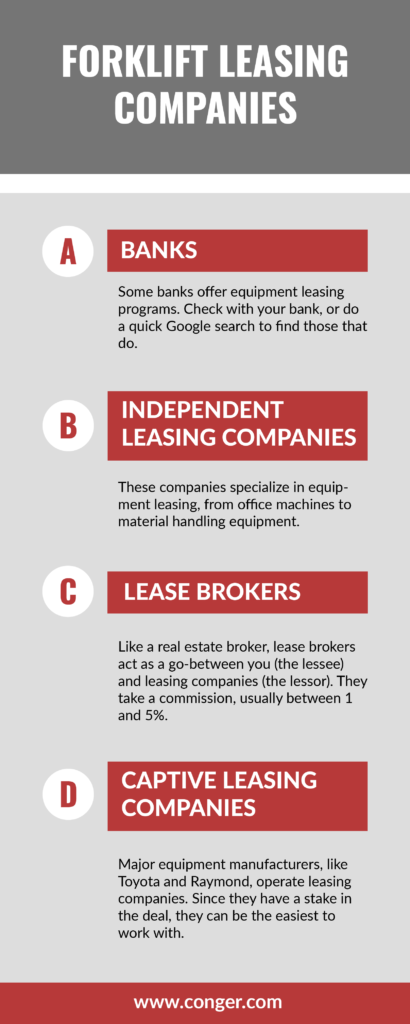
Banks
Simple and obvious, you may want to start with your bank.
If your bank doesn’t offer a leasing program, you can check online for other banks that do.
A quick Google search returns multiple options:
Lease Brokers
Lease brokers are like real estate and insurance brokers.
They act as intermediaries between you and the loan provider.
They understand the lay of the leasing land and can help you find loan companies willing to work with your specific circumstances.
But you will pay a commission fee – typically 1 to 5% – making it more expensive than going directly to a leasing company.
Independent Leasing Companies
Independent leasing companies specialize in helping companies acquire business equipment.
They tend to have lots of experience in the field, so they can be an excellent partner in helping you choose the right leasing options for your situation.
According to QuickSprout.com, the top 6 equipment leasing companies are:
- Gordon Flesch Company
- Crest Capital
- National Business Capital
- US Business Funding
- Smarter Finance USA
- Wells Fargo
Additionally, many independent leasing companies offer in-house or contracted maintenance services to keep your equipment in good shape.
Captive Leasing Companies
If you lease through the dealership where you get your forklift from, chances are they’ll work with their manufacturer’s captive leasing company.
A captive leasing company is a financing company owned and/or operated by the equipment manufacturer.
They offer the most flexibility since the leasing company has a stake in the deal – they want you to lease their equipment!
Some examples of captive forklift leasing companies include:
10 Questions to Ask Before Signing a Lease
Now that you know the different lease types, how to decide between buying and leasing, and where to find forklift leasing companies, let’s go through the top 10 questions you should ask before signing a lease (all courtesy of Toyota).
-
When and where does the forklift need to be returned?
-
What condition does the lift truck need to be in to avoid extra charges?
-
What all needs to be returned with the lift (keys, owner’s manuals, etc.)?
-
How and when should bills be paid?
-
Is there a grace period?
-
Are there late fees?
-
Can I end the lease early? If so, what are the charges?
-
When are service hours counted?
-
What happens if I go over my allotted service hours?
-
How much will it cost to purchase my forklift after the lease?
Conclusion
There you have it: the complete guide to forklift leasing.
Now we’d like to turn it over to you.
Have you leased or bought a forklift recently?
If so, what did you learn?
Would you do things the same if you could go back?
